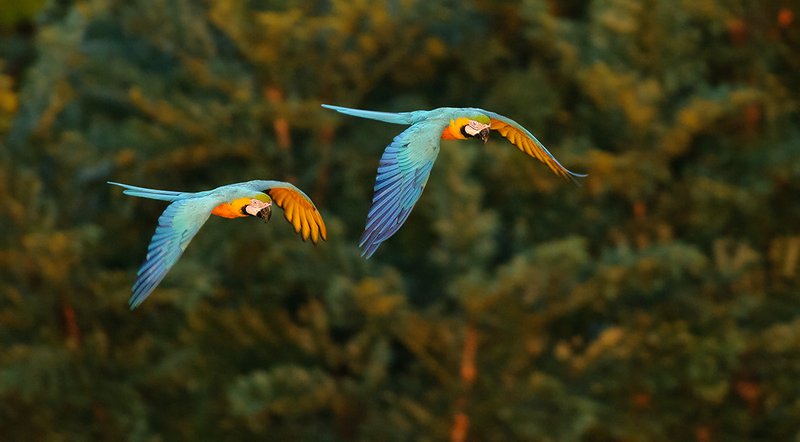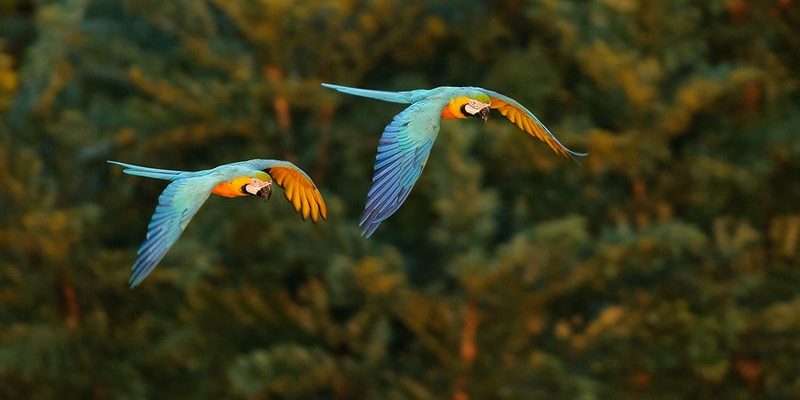
Imagine you’re sipping a cup of coffee, chatting with a friend about exotic pets. You mention how much you adore the blue-and-yellow macaw. Your friend, intrigued, asks what makes them so special. You might start sharing some fun facts, painting a picture of their lively nature and unique characteristics. By the end of your conversation, you’ll not only have a better understanding of these beautiful birds but a deeper appreciation for their role in our world.
1. Stunning Coloration
Blue-and-yellow macaws stand out due to their striking plumage. Their feathers are a brilliant mix of electric blue on the back and rich yellow on the belly. It’s almost like nature took a paintbrush and went wild! This eye-catching combination isn’t just for show; it helps them blend in among the lush foliage of their rainforest habitat.
But here’s the thing: all that beauty comes with a purpose. The vibrant colors can help them find mates or warn off potential threats. Just like how we might dress up to impress or to blend in at a party, these macaws use their feathers to communicate, too.
2. Social Butterflies
If you’ve ever watched a blue-and-yellow macaw in action, you’ll know they’re social creatures. These birds thrive in large flocks, often seen playing and grooming each other. It’s like they’re the life of the party, always engaging in lively chatter and playful antics.
You might be wondering why they crave social interaction so much. Well, in the wild, being part of a flock helps them stay safe from predators. Plus, they’re intelligent animals that require mental stimulation, and spending time with their buddies keeps their minds sharp and happy.
3. A Long Lifespan
Blue-and-yellow macaws are not just pretty faces; they’re also impressively long-lived. In captivity, they can live up to 50 years or even longer, while in the wild, they typically have a lifespan of around 30 to 40 years. That’s a commitment if you’re thinking about adopting one as a pet!
Their long lifespan means they form strong bonds with their owners. Just imagine having a feathered friend that could be part of your family for decades! You’ll want to make sure you’re ready for that kind of dedication.
4. An Impressive Diet
These beautiful birds have a diverse diet that includes nuts, seeds, fruits, and occasionally flowers. Their strong, curved beaks are perfectly designed for cracking open tough nuts—practically their version of a snack time!
Here’s a fun fact: in the wild, blue-and-yellow macaws play a vital role in their ecosystem. By eating fruits and then dispersing the seeds through their droppings, they help to grow new plants. It’s a win-win situation! They get to munch on delicious meals while also contributing to the health of their habitat.
5. Intelligent Learners
Blue-and-yellow macaws are among the smartest bird species out there. They can learn to mimic human speech and sounds quite impressively. Some owners even train them to do tricks, turning their home into a little circus show!
But their intelligence isn’t just about entertainment. It also means they need plenty of mental stimulation. Without it, they can become bored or even depressed. So if you’re thinking about bringing one home, be prepared for some interactive puzzle toys and regular training sessions.
6. Unique Nesting Habits
In the wild, blue-and-yellow macaws prefer to nest high up in trees, using natural hollows to lay their eggs. These cozy spots keep their young safe from predators and provide a snug environment for raising their chicks.
Interestingly, they typically lay between 2 to 4 eggs at a time. Both parents are involved in nurturing their little ones, teaching them everything from flying to finding food. It’s a heartwarming example of teamwork in the animal kingdom!
7. A Threatened Species
Unfortunately, blue-and-yellow macaws face threats from habitat loss and the illegal pet trade. Deforestation is a major issue, as it diminishes their natural habitat and food sources. We humans must take action to protect these gorgeous birds and ensure they continue to thrive in the wild.
Conservation efforts are underway, and awareness is growing. By supporting organizations that focus on protecting their habitats, you can help make a difference. Every little bit counts when it comes to preserving these magnificent creatures.
8. Communication Masters
Blue-and-yellow macaws are known for their loud calls, which can travel over long distances. They use a variety of vocalizations to communicate with each other, whether it’s alerting flock members of danger or calling their mates.
Just imagine being in the heart of the rainforest, surrounded by the sounds of nature, and suddenly hearing their distinctive squawks! It’s a reminder of how social and communicative these birds are, almost as if they’re hosting their own lively conversation above the treetops.
9. Beautiful Bonding Rituals
These macaws engage in a variety of bonding behaviors that strengthen their social ties within the flock. They often engage in preening, which is when they clean each other’s feathers. It’s not just about grooming; it’s a sign of affection and trust!
You might notice that they also engage in playful antics, like chasing each other or playing tag. These behaviors highlight their need for companionship and play, reflecting their joyful personalities.
10. The Importance of Enrichment
If you’re considering a blue-and-yellow macaw as a pet, you’ll need to focus on their need for enrichment. This means providing plenty of toys, activities, and interaction to keep them stimulated. Boredom can lead to behavioral issues, so you’ll want to keep their lives as interesting as possible.
Think of it like this: would you enjoy life in a dull room with nothing to do? Absolutely not! By offering engaging activities, you can ensure your feathered friend stays happy, healthy, and vibrant.
As we wrap up this journey into the world of blue-and-yellow macaws, it’s clear they are remarkable creatures filled with personality and charm. Whether in the wild or as beloved companions, their presence adds color and joy to our lives. So next time you see one, remember all the fascinating details that make them so special!

